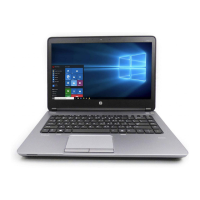i. Reboot the system. If the system has a Trusted Platform Module (TPM) and/or fingerprint
sensor, one or two prompts will appear. One to clear the TPM and the other to Reset
Fingerprint Sensor; press F1 to accept or F2 to reject.
j. Remove all power and system batteries for at least 24 hours.
2. Remove and retain the storage drive or clear the contents of the drive.
Clear the drive contents by using the BIOS Setup Secure Erase command option, or by using a
third party utility designed to erase data from an SSD. To run Secure Erase, follow these steps:
a. Enter BIOS Setup by powering on the system, and then pressing F10 when prompted near
the bottom of the display.
b. Select the Security menu and scroll down to the Utilities menu.
c. Select Hard Drive Tools.
d. Under Utilities, select Secure Erase, and then select the desired hard drive.
Non-volatile memory usage
Non Volatile
Memory Type
Amount (Size) Does this
memory
store
customer
data?
Does this
memory
retain data
when
power is
removed?
What is the
purpose of
this
memory?
How is data input into
this memory?
How is this memory
write protected?
Real Time Clock
(RTC) battery
backed-up
CMOS
configuration
memory (CMOS)
256 Bytes No Yes Stores system
date and time
and limited
keyboard
controller
data.
Using the F10 Setup utility
or changing the M
Windows date & time.
This memory is not
write-protected. HP
recommends password
protecting the F10
Setup utility.
Controller (NIC)
EEPROM
64 Kbytes (not
customer
accessible)
No Yes Store NIC
configuration
and NIC
firmware.
Using a utility from the NIC
vendor that can be run
from DOS.
A utility is required to
write data to this
memory and is
available from NIC
vendor. Writing data to
this ROM in an
inappropriate manner
will render the NIC
non-functional.
Keyboard ROM 64 Kbytes (not
customer
accessible)
No Yes Stores
firmware code
(keyboard,
mouse, &
battery
management)
.
Programmed at the
factory. Code is updated
when the system BIOS is
updated.
A utility is required for
writing data to this
memory and is
available on the HP
website. Writing data to
this ROM in an
inappropriate manner
can render the PC non-
functional.
DIMM Serial
Presence Detect
(SPD)
configuration
data
256 Bytes per
memory
module, 128
Bytes
programmable
(not customer
accessible)
No Yes Stores
memory
module
information.
Programmed by the
memory vendor.
Data cannot be written
to this memory when
the module is installed
in a PC. The specific
write protection method
varies by memory
vendor.
90 Chapter 9 Statement of Volatility

